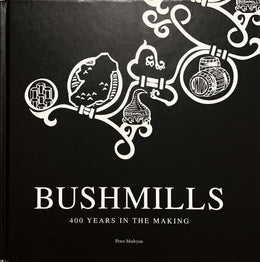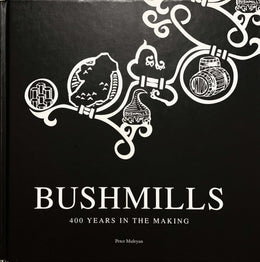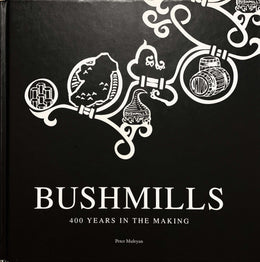According to ancient rules, a "great liquor" is one which improves with aging. A definition that is still very much in use today.
With maturation there occurs a change in the chemical composition of the basic elements of a newly distilled Whisky. However, technicians and chemists have not yet well understood the physiognomy of the process which causes, in fact, an exaltation of the components through the concentration of volatile substances, furfural and tannins, with a consequent increase in its aroma. Proper aging can only be achieved in adequately porous wooden casks, so that the distillate can oxidize, evaporate and draw essences from the wood via the action of the alcohol.
These new essences react with each other, and then with the original components of the Whisky, which will have already interacted with each other.
The oxidation of ethyl alcohol brings about the formation of acetic acid which, in turn, reacts with the alcohols, giving rise to esters: a large family of volatile chemical compounds that comprises some of the most pleasant components of Whisky.
Among the substances extracted from the wood we find lignin, which gives it a sweet smoothness (vanilla), and tannins, which provide aromatic complexity and structure. The original quality of the Whisky will have to be perfect, since the wood multiplies its virtues but, in the same way, also highlights its defects.
The wood of a cask must come from a plant with a lifespan of at least 80 years. Experience has shown that American oak turns out to be the best, because it concentrates caramelized notes, it confers sweetness, gives off vanilla (lignin) and contains high quality tannins that bestow a facet of flavor with astringency, softness and aromatic complexity. This type of wood also possesses the optimal porosity for an oxidation which favors fruity aromas, roughness and affirms complexity. In order to obtain a great liquor, the wood is essential, and the highest level of aging is achieved through absolutely new, never before used casks.

The difference between adopting a new cask rather than a salvaged one, is absolutely obvious, almost prodigious. Considering the current industrialization of production processes, the custom of aging in new casks ("fresh fills"), for those who wish to attain a classy Whisky, is the only choice in the near future.
The sore point is in the fact that a new cask is very expensive and often more so than the new Whisky with which it is filled. Consequently, few can afford the luxury of employing new casks. Virtually nobody does this, except incidentally, or upon running out of the recycled ones.
Unique to certain large manufacturers of Cognac that do not distil independently, is the fact that they instead require of their suppliers that the purchased stock has not been matured in new casks. The explanation lies surely in desiring a very refined spirit, not excessively loaded with aromas. In fact, one of the basic requisites for a proper Cognac consists in its extreme elegance.
Elegance is a property that I appreciate enormously and, though it is not exactly a characteristic and essential detail of Whisky, it represents a necessary dimension, a sine qua non. There are certain Speyside Whiskies that, with a softly peated flavor, at around 12 years of aging reveal such grace and finesse in their aroma, to be comparable to a great Cognac. Such peculiarity is frequently found in long aged Whiskies, which are the ones I prefer overall.
A newly distilled malt spirit possesses an alcoholic content ("proof") of 71-74 degrees, and must be diluted with spring water to 63-65 degrees before being decanted into various casks.
In selecting the casks that will then be bought, we must take this detail into account because if this alcohol reduction hasn't been implemented, the aging quality will be below average.
The traditional cask is the Hogshead, which holds about 250 liters. Butts (typically used as casks for Sherry) and Puncheons are rarer, which both contain about 500 liters each. The smallest cask is the Barrel, with a capacity of about 120 liters, more commonly used for Rum than Whisky. It is therefore clear that the 500 liter Sherry cask safeguards Whisky better in long aging processes (thirty years and above) than small casks do.
Instead, in minute casks, which I particularly avoid, aging is rather stressed and the spirit's development too hasty and brisk. A good maturation must also be a long-lasting one. Obviously, waiting times will lengthen and costs will exacerbate. Sherry casks give off their peculiar aroma and color, accentuate the most delicate and refined components, with particular attention to the aldehyde and ester tones.
On a June morning in 1969 I came to a picturesque distillery near Elgin, in the heart of Speyside. My visit had been preceded by the best Scottish tradition. The director, one Mr. Gordon, kindly showed me around every corner of the distillery.
A lovely place, I must say, at the edge of the woods, with a natural lake of spring water where a pair of swans lazily swam. At the end of my pleasant visit I was taken to the office to sign the visitors' log book and taste a Whisky. I will start by saying that in the morning I always wake up so late that, when I have an appointment, I go out without ever having the time to down anything. A glass of Whisky in the early morning - at least for me - worried me quite a bit. I remembered that in the past newbie Scottish managers, once they began their training, every morning, on an empty stomach, had to swallow a generous dose of 60 degree Whisky, straight from the cask.
I therefore put myself in the shoes of these strapping young men that had to run the gauntlet before getting their license. It was a baptism for me as well, but, at the same time, a truly magical experience.
From a compartment hidden in the boiserie behind the desk, Mr. Gordon brought out an Edinburgh crystal bottle containing a very dark liquid and slowly, carefully, poured a brimming portion into an old fashioned crystal glass.
I was rather intrigued by the color, bizarre and unusual for me back then, of that spirit. But the aroma did not reveal the traces of caramel I was expecting; rather something like vanilla and then, suddenly, a sharp winy scent. At that point I could no longer hold my curiosity back and drank. A Whisky different from what I knew at the time. Broad, rich, fragrant. It was a revelation, I could never have imagined that a malt could reach such fantastic levels.
This Malt Whisky was a mere 12 years old, aged in a cask that had previously held Spanish Sherry wine. Bottled at its natural strength, which was 57 degrees, exactly as it had come from the cask, lacking any reduction with water. But it was not aggressive, and the alcohol was so well balanced in its robust structure, that it was drunk with great ease. With every sip, indeed, it won you over further. That had been my breakfast and, simultaneously, an aperitif; and even though I ended up a bit euphoric on my way back to the hotel, I wasn't even slightly bothered by it, and ate heartily.
I had discovered "Sherry Wood" and "Full Proof", or "Natural Strength”.
It was only some years later that I was lucky enough to be acquainted with yet another Whisky aged in Sherry casks. In 1974 I arrived in Glasgow, on a rainy September morning with a friend and client. We had an appointment with a Mr. Black, CEO of Longman Distillers Limited.
We were ushered into the Blender room and, upon a table, at least forty samples had been prepared. Still in hopes of repeating the encounter in Elgin, my first glance was always cast toward very dark colors. A Sherry Wood Malt does not always have such a dark tint: it depends exclusively on the type - and so the color - of wine used.
But I hadn't been aware then.
In any case, I thought to have seen one, but conveniently waited until the samples had been illustrated one by one.
Mr. Black had then explained to me that this type of cask had been regularly used until shortly after the last War, but this tradition had then been abandoned and in that moment Sherry casks did not exceed 0.25% of the overall cask stocks in Scotland.
After this interesting explanation we were brought to a hall: upon the large conference table, were three nose glasses (glasses used by blenders) lined up. Mr. Black then immediately disappeared to the office and returned with a fourth glass, the content dark to the point of assuming that it was in fact Sherry Wood.
With a wave of his hand, he invited me to begin tasting. In a few minutes I declared that the first was a 5 year old malt, the second a 12 year old malt, the third a malt between 17 and 18 years old. The fourth was an indescribable and undrinkable liquid. And I told him so.
I had guessed everything right, including the fourth sample it. Mr. Black had then confessed that to put me to the test, in the office he had taken a random Whisky, and had added Sherry from a bottle. I'd bought everything they'd offered me. It had been a great success and all of my clients had been pleasantly surprised and enthusiastic.
A cask can bear a maximum of three aging cycles with proper interventions of cooperage, through which the deteriorated planks are substituted with new ones. Over 30 years, impure substances tend to permeate all the wood of a cask that, in this way, has nothing left to yield.

Evaporation causes a significant loss in volume and alcohol content (calculated at about 2% per year on average). A Hogshead with a capacity of 160 anhydrous liters (250 liters at 64 degrees), is reduced to 121 anhydrous liters after 12 years and will produce, upon bottling, about 276 bottles at 57 degrees or 405 bottles at 40 degrees. As we can see, cost-wise a bottle at 57 degrees corresponds to about a bottle and a half of a Whisky at 40 degrees.
On the subject of alcohol content, we should keep a fundamental rule in mind: the more a Whisky has the characteristics to express itself in terms of aromas, perfumes and body, the more its alcohol percentage may be accentuated ; the less it is rich and textured, the more its proof will be moderate. A colorless and neutral distillate couldn't hold a high alcoholic strength, which would end up being separate, raw and discordant as compared to the other components . Instead, in a well-structured spirit, the alcohol acts as a conductor and coordinator of all the aromatic and gustatory compounds.
In a damp storehouse there is a greater loss of alcohol, while in a relatively dry one a greater quantity of water evaporates. Further variants may develop if the warehouse is located in the vicinity of the ocean or a mountain, and if the cask is stored high or low.
Centuries of experience have taught us that very cold and humid climates prove to be optimal for the maturation of spirits, therefore reiterating the importance of a microclimate . However, this condition requires long waiting times, whereas in the tropics Rum is already considered too old after only six years, because of a more or less humid, though excessively hot, climate. The slower the process, the better the quality.
Each cask has a unique characteristic, which often drowns out the personality of the distillery itself. It is therefore naive to believe that behind the typical label of a Whisky the same quality will always be found. If this happens, the quality standard is pretty mediocre.
A Single Malt can be relatively aged even after just 8 years, never 5. Generally it is believed that the older it is, the better; however, there is no rule of the sort, because the variants are endless.
A Whisky rarely reaches thirty years of aging successfully, but when this happens, the highest possible quality is achieved. The perfumes are closed, the aromas more delicate and elegant, the body dry.
We must devote time and every sense we possess to its tasting. This Whisky proves to be less immediate but, at the same time, satisfy the most. These are the Whiskies that I love more than any other. But beyond this point, Whisky increasingly loses body, perfecting its typical aroma and taste. It risks picking up all the flaws of the cask such as its mold, tannic excess, a loss of structure and so on. The perfume, however, only intensifies. Unfortunately, it isn't any good to drink, because all you would feel in your mouth would be water, alcohol and tannin.
I personally feel that the term "aging" is horrible, but in this case - and only in this case — it reflects exactly what happens: old age, attrition, decline, decay. It is the flaw that comes with excessive aging.
Long maturation processes are partially protected in large casks, such as 500 liter Butts or Puncheons, since the spirit makes less contact with the wood and pores of the cask, as compared to what happens in smaller casks. Despite the possible defect of excessive aging, its smell is still extraordinary; but what of salvaging it? The answer is simple: just supply it with the structure it is missing by mixing it with a younger batch (which we'll see in the chapter on mixing, at p. 87).
In any case, British law calls for a minimum of 3 years of aging for Scotch Whisky, and the aging stages are strictly guaranteed by the supervision of the Queen's officials.
Written by Silvano Samaroli
The text is an excerpt from "Whisky Eretico" (pp. 65 - 73), written by Silvano S. Samaroli, published 2017 by The Whisky Library, The Library Group Limited.







